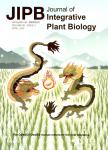Regulation of root secondary metabolites by partial root-associated microbiotas under the shaping of licorice ecotypic differentiation in northwest China
Regulation of root secondary metabolites by partial root-associated microbiotas under the shaping of licorice ecotypic differentiation in northwest China作者机构:State Key Laboratory of Crop Stress Biology for Arid AreasShaanxi Key Laboratory of Agricultural and Environmental MicrobiologyCollege of Life ScienceNorthwest A&F UniversityYangling 712100China
出 版 物:《Journal of Integrative Plant Biology》 (植物学报(英文版))
年 卷 期:2021年第63卷第12期
页 面:2093-2109页
核心收录:
学科分类:1008[医学-中药学(可授医学、理学学位)] 0710[理学-生物学] 10[医学]
基 金:funded by the National Natural Science Foundation of China(41830755 42122050 42077222 and 41807030)。
主 题:genotyping-by-sequencing Glycyrrhiza uralensis Fisch rhizosphere secondary metabolites single nucleotide polymorphisms
摘 要:Interactions between plant hosts and their microbiotas are becoming increasingly evident,while the effects of plant communities on microbial communities in different geographic environments are poorly understood.Here,the differentiation of licorice plant ecotypes and the distribution of rootassociated microbiotas were investigated across five sampling sites in northwest China.The interactions between the environment,plant and microbial communities,and their effects on licorice root secondary metabolites,were elucidated.The plant community was clearly differentiated into distinct ecotypes based on genotyping-by-sequencing and was primarily driven by geographic distance and available soil nitrogen.The bulk soil and rootassociated microbiotas(rhizosphere soil and root endosphere)partially correlated with plant community,but all were significantly discriminated by plant clade.Moreover,these microbiotas were explained to different extents by distinct combinations of environment,geography,and plant community.Similarly,three structural equation models showed that licorice root secondary metabolites were complicatedly modulated by multiple abiotic and biotic factors,and were mostly explained by these factors in the rhizosphere model.Collectively,the results provide novel insights into the role of environment–plant–microbiota interactions in regulating root secondary metabolites.That should be accounted for when selecting appropriate licorice planting sites and management measures.



